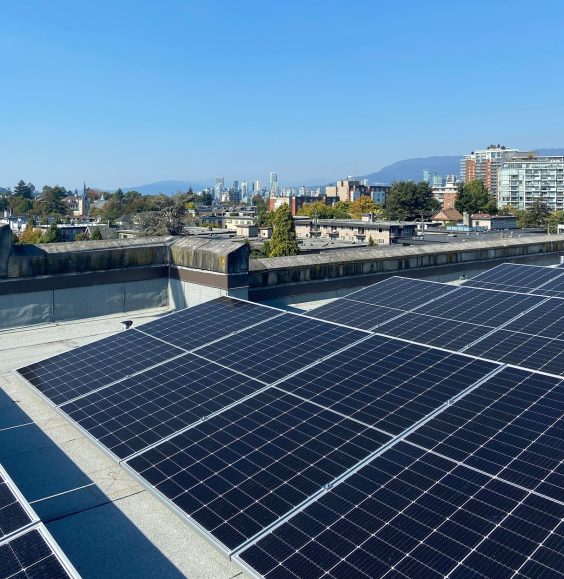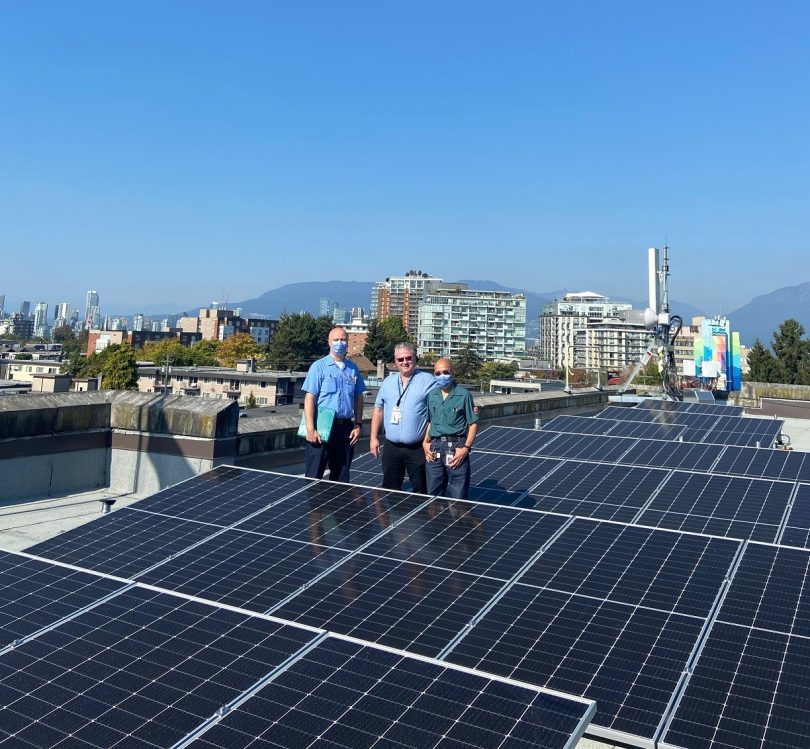Several weeks ago, Providence Health Care’s Mount Saint Joseph Hospital activated 102 solar panels. Each panel is rated at 540 watts and the array is expected to produce 53,750 kilowatt hours (kWh) a year.
For context, the average annual household usage in British Columbia (BC) is 10,000kWh, so this system will produce enough electricity to power the equivalent of approximately five BC houses.
Not only that, but the hospital is the first health care facility in the Lower Mainland using this type of solar panel. While standard panels are between 300-400W, these LONGi panels are 540W, allowing for lower installation costs because fewer panels produce more energy.
Serendipitous timing
The installation of solar panels at Mount Saint Joseph has been in the works for a while (nearly two years!), but it was serendipitous timing for the project when it was determined the 1944 and 1955 buildings at the hospital were in need of a roof replacement regardless.

Anthony Munster, Executive Director of Projects, Planning & Facilities Management shares it was decided Providence would add solar panels at the same time it finished roof replacement work. He says combining the two projects lowered the cost of the installation process, while the installation and use of the panels will reduce the overall utility bills for the hospital, and the new roofs allowed the installation to meet the City of Vancouver seismic and wind uplift requirements.
Shrinking Providence Health Care’s environmental footprint
The energy generated by the panels is 100-per-cent renewable, which offsets greenhouse gas (GHG) emissions that would normally occur through receiving energy from the usual utility grid.
“Electrical capacity is constrained at all of our sites,” says Munster. “As we move towards reducing our greenhouse gas emissions, we need extra power capacity in order to install new equipment.”
That’s where solar comes in. The installation of solar panels, when coupled with the LED lighting upgrades that are already underway, means capacity on the usual power grid is freed up, allowing for other systems that maybe can’t be powered by solar to get the power they need to function. This in turn allows for more GHG reducing initiatives to be put in place.
Mount Saint Joseph’s daily electricity requirements are approximately 600 kilowatts. With these newly installed solar panels pulling in electricity all year round, even when it’s raining, there’s a lot more space on the hospital electrical grid to install other GHG-reducing items. This includes heat pumps for cooling—systems that reject heat into other systems to then be reclaimed to help keep the temperatures in the hospital within a comfortable range for patients, residents and staff.
Visible commitment to sustainability

“Unlike the other GHG reduction projects which have been taking place behind the scenes, these panels are a visible reminder of our commitment to sustainability,” says Munster.
And while they may look as though they’ve been placed haphazardly across the roof, it’s actually a very precise process. Each panel needs to be at a 12-degree angle to ensure maximum sunlight when considering the latitude of Vancouver. Additionally, the panels need to be placed so they aren’t obstructed or shaded by each other or by other infrastructure. It’s quite complex.
While there are still more panels to be installed on the remaining section of the Mount Saint Joseph roof, once complete, other sites will be receiving the technology as well.
And these solar panels are just one of the many ways Providence Health Care is making a difference when it comes to reducing GHG’s and the organization’s environmental footprint; there is much more to come.





